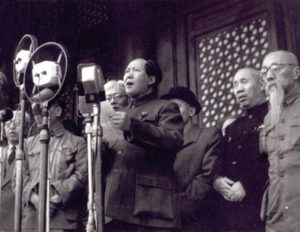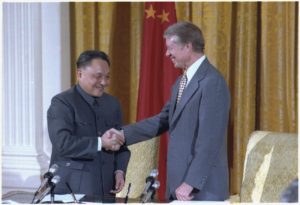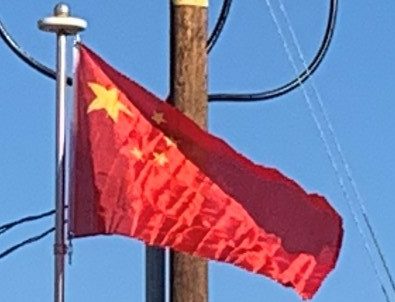After the surrender of Japan in 1945, Taiwan, including the Pescadores, was returned to Chinese control. China emerged victorious but war-ravaged and financially drained. The continued distrust between the Kuomintang and the Communists led to the resumption of civil war. Constitutional rule was established in 1947, but because of the ongoing unrest, many provisions of the ROC constitution were never implemented in mainland China.
People’s Republic (1949–present):
Major combat in the Chinese Civil War ended in 1949 with the Communist Party in control of most of mainland China, and the Kuomintang retreating offshore, reducing its territory to only Taiwan, Hainan, and their surrounding islands. On 21 September 1949, Communist Party Chairman Mao Zedong proclaimed the establishment of the People’s Republic of China with a speech at the First Plenary Session of the Chinese People’s Political Consultative Conference. This was followed by a mass celebration in Tiananmen Square on 1 October, at which the proclamation was made publicly by Mao at the Tiananmen Gate, the date becoming the new country’s first National Day.

In 1950, the People’s Liberation Army captured Hainan from the ROC and incorporated Tibet. However, remaining Kuomintang forces continued to wage an insurgency in western China throughout the 1950s.
The regime consolidated its popularity among the peasants through land reform, which included the execution of between 1 and 2 million landlords. China developed an independent industrial system and its own nuclear weapons. The Chinese population increased from 550 million in 1950 to 900 million in 1974. However, the Great Leap Forward, an idealistic massive reform project, resulted in an estimated 15 to 35 million deaths between 1958 and 1961, mostly from starvation. In 1966, Mao and his allies launched the Cultural Revolution, sparking a decade of political recrimination and social upheaval that lasted until Mao’s death in 1976. In October 1971, the PRC replaced the Republic in the United Nations, and took its seat as a permanent member of the Security Council.
After Mao’s death, the Gang of Four was quickly arrested and held responsible for the excesses of the Cultural Revolution. Deng Xiaoping took power in 1978, and instituted significant economic reforms. The Party loosened governmental control over citizens’ personal lives, and the communes were gradually disbanded in favor of working contracted to households. This marked China’s transition from a planned economy to a mixed economy with an increasingly open-market environment. China adopted its current constitution on 4 December 1982. In 1989, the violent suppression of student protests in Tiananmen Square brought sanctions against the Chinese government from various countries.

Jiang Zemin, Li Peng and Zhu Rongji led the nation in the 1990s. Under their administration, China’s economic performance pulled an estimated 150 million peasants out of poverty and sustained an average annual gross domestic product growth rate of 11.2%. The country joined the World Trade Organization in 2001, and maintained its high rate of economic growth under Hu Jintao and Wen Jiabao’s leadership in the 2000s. However, the growth also severely impacted the country’s resources and environment, and caused major social displacement. Living standards continued to improve rapidly despite the late-2000s recession, but political control remained tight.
